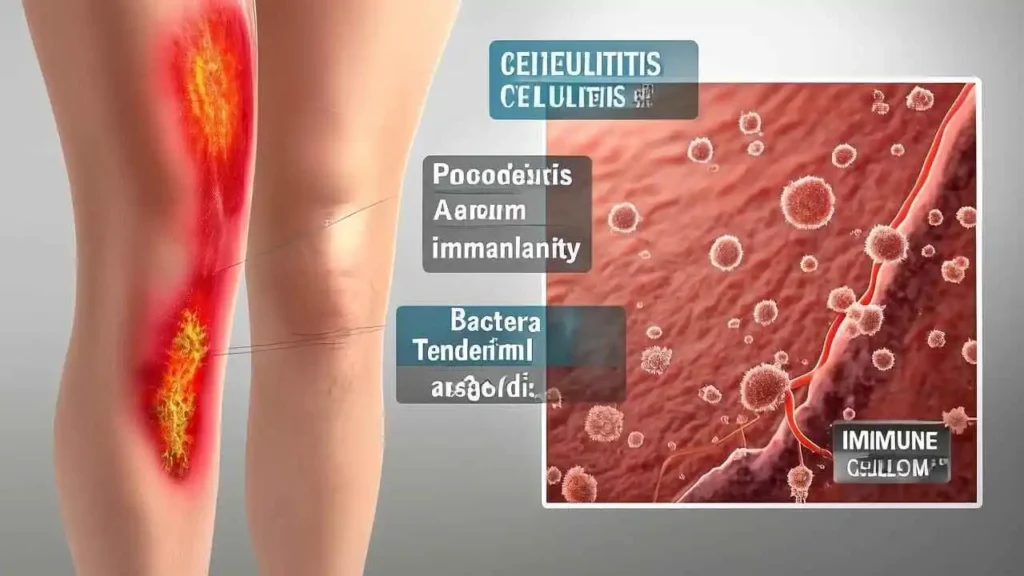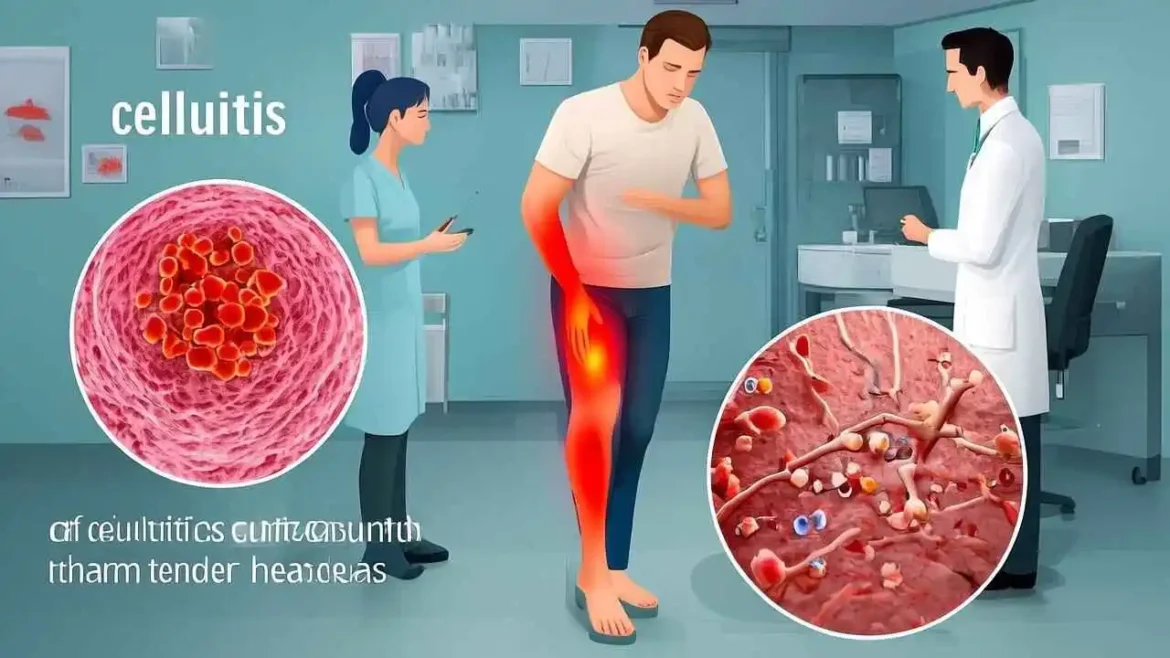
Understanding Cellulitis:Causes,Symptoms,Diagnosis,and Treatments
Cellulitis is a common bacterial skin infection that affects millions of people worldwide each year. It occurs when bacteria, usually Streptococcus or Staphylococcus, enter the body through a break in the skin, such as a cut, scrape, or insect bite. Once inside, the bacteria multiply and cause inflammation and infection in the skin’s deeper layers. If left untreated, cellulitis can lead to serious complications, including blood infection (sepsis) and tissue death (necrosis).
In this article, we will explore the causes, symptoms, diagnosis, and treatments of cellulitis, as well as provide some tips for prevention.
Causes of Cellulitis
Cellulitis is a common bacterial skin infection that can be quite serious if not treated promptly. It primarily affects the deeper layers of the skin, specifically the dermis and subcutaneous tissue. The core mechanism behind its development is the entry of bacteria into the body through a breach in the skin’s protective barrier. The most common bacterial culprits are Streptococcus and Staphylococcus species, which are ubiquitous on the skin’s surface but become problematic when they gain access to underlying tissues.
The integrity of the skin acts as a crucial defense against these pathogens. However, various common scenarios can compromise this barrier, creating opportunistic entry points for bacteria. These include, but are not limited to, the following:
- Cuts and scrapes: Even minor abrasions, cuts, or scratches, whether from everyday activities, falls, or shaving, can serve as portals for bacteria. The size of the wound isn’t always indicative of the risk; even microscopic breaks can be enough.
- Insect bites: Bites from insects like mosquitoes, spiders, or fleas can create small openings in the skin. Subsequent scratching of these often itchy bites can further break the skin and introduce bacteria from the fingernails, which harbor numerous microorganisms.
- Animal bites: Bites from pets or wild animals, which often carry a variety of bacteria in their mouths, can deeply puncture the skin and directly inject pathogens into the tissue. Cat bites, in particular, are known for their deep puncture wounds that are difficult to clean.
- Surgical wounds: Incisional wounds from surgery, especially if not kept clean, can become infected before or after sutures are removed, as the healing process can be slow or compromised. Post-operative care is crucial to minimize this risk.
- Skin ulcers: Chronic skin wounds such as pressure sores (bedsores), diabetic foot ulcers, or venous stasis ulcers represent open, non-healing wounds that are highly susceptible to bacterial colonization and infection. These are particularly concerning as they can penetrate deep into tissues.
- Athlete’s foot (Tinea pedis): This common fungal infection causes cracks, peeling, and maceration of the skin, particularly between the toes. These fissures provide direct pathways for bacteria to enter the underlying tissues, even if the fungal infection itself isn’t bacterial.
- Eczema (Atopic dermatitis): Chronic inflammatory skin conditions like eczema leave the skin dry, itchy, and prone to cracking and breakdown. Constant scratching further damages the skin barrier, making it inherently vulnerable to bacterial infection and recurrent cellulitis.
Other potential entry points include puncture wounds (e.g., stepping on a nail), burns, blisters, intravenous (IV) drug use injection sites, and body piercings.
Beyond direct skin breaks, certain underlying health conditions and lifestyle factors significantly elevate an individual’s risk of developing cellulitis. A cornerstone risk factor is a compromised immune system, which hinders the body’s ability to effectively fight off invading bacteria.
- Diabetes: Individuals with diabetes are particularly vulnerable due to a combination of factors including impaired immune function, poor circulation (leading to slower healing and reduced blood flow to fight infection), and nerve damage (neuropathy) which can prevent them from noticing minor skin injuries and infections promptly.
- HIV/AIDS: People with HIV/AIDS experience generalized immune suppression, making them susceptible to a wide range of opportunistic infections, including cellulitis, as their body’s defense mechanisms are weakened.
- Other Immunosuppressive Conditions/Treatments: This category also includes those undergoing chemotherapy, organ transplant recipients on immunosuppressant drugs, or individuals with chronic conditions like chronic kidney disease or liver disease that affect immune function.
Symptoms of Cellulitis
Cellulitis is a common, yet potentially serious, bacterial skin infection that can affect individuals of all ages. While it can manifest on any part of the body, including the face, arms, or abdomen, it most frequently affects the lower legs. This often occurs following a break in the skin, however minor, such as a cut, scrape, insect bite, surgical incision, or even a crack in dry skin, which allows bacteria (commonly Streptococcus or Staphylococcus) to enter.
The onset of symptoms can be remarkably swift, often developing within a matter of hours or days after the initial entry point for bacteria, underscoring the rapid progression of this infection. Key symptoms to watch for include:
- Red, Swollen, and Tender Skin: The most characteristic sign is an area of skin that appears distinctly red, often with a shiny, stretched appearance. The redness may spread rapidly and, while sometimes having a somewhat defined border, it can also be diffuse. The affected skin will feel noticeably swollen and exceptionally tender and painful to the touch, indicating inflammation and infection.
- Warmth in the Affected Area: Due to the intense inflammatory response and increased blood flow to the infected site, the skin over the cellulitis will feel distinctly warm or hot compared to the surrounding unaffected skin.
- Pain or Tenderness: Beyond just tenderness to touch, individuals often experience a constant, throbbing, or aching pain in the affected area. This pain can range from mild discomfort to severe, debilitating pain, often worsening with movement or pressure.
- Fever: As the body’s immune system fights the infection, a fever (oral temperature typically 100.4°F/38°C or higher) is a common systemic symptom, indicating the infection is spreading beyond the localized skin area.
- Chills: Often accompanying the fever, episodes of chills, sometimes severe enough to cause shivering, signify the body’s systemic response to the bacterial invasion.
- Fatigue: A general feeling of malaise, weakness, and persistent tiredness is common as the body expends energy fighting the infection, making daily activities difficult.
- Blisters or Sores: In more severe or advanced cases, fluid-filled blisters (bullae) may develop on the surface of the infected skin. These can sometimes rupture, leading to open sores and increasing the risk of further infection. In very severe cases, the skin may even begin to look mottled or discolored.
- Swollen Lymph Nodes: The lymph nodes located near the affected area (e.g., in the groin if cellulitis is on the leg, or in the armpit if on the arm) may become enlarged, tender, and palpable. This indicates that the lymphatic system is actively working to filter and contain the infection.
Given the potential for rapid progression, it is absolutely essential to seek immediate medical attention if you suspect you have cellulitis or experience any combination of these symptoms. Untreated or delayed treatment of cellulitis can lead to serious complications, including:
- Sepsis: The infection can spread to the bloodstream, leading to a life-threatening widespread inflammatory response throughout the body.
- Tissue damage: In severe cases, the infection can cause significant destruction of skin and underlying tissues, potentially requiring surgical intervention.
- Spread to other parts of the body: The bacteria can spread to bones (osteomyelitis), joints (septic arthritis), or even the heart valves (endocarditis).
- Recurrent infections: Without proper management and identification of predisposing factors, cellulitis can become a recurring problem.
Early diagnosis and treatment with antibiotics are crucial for preventing these severe outcomes and ensuring a full recovery. Do not delay seeking professional medical advice.
If you experience any of these symptoms, it is essential to seek medical attention promptly, as cellulitis can progress quickly and lead to severe complications.
Diagnosis of Cellulitis
A healthcare provider will typically diagnose cellulitis based on a physical examination and your medical history. They may also perform a blood test or take a sample of the affected tissue for further analysis. In some cases, imaging tests, such as X-rays or ultrasounds, may be necessary to rule out other conditions, such as deep vein thrombosis or a bone infection.
The accurate and timely diagnosis of cellulitis is crucial for effective treatment and to prevent potential complications. A healthcare provider will typically embark on a multi-faceted approach, combining clinical assessment with diagnostic tests when necessary.
1. Clinical Assessment: Physical Examination and Medical History
The primary method for diagnosing cellulitis involves a thorough physical examination by an experienced healthcare provider. During this examination, the doctor will meticulously inspect the affected area, looking for characteristic signs and symptoms such as:
- Erythema: Redness of the skin, which may be warm to the touch.
- Swelling (Edema): The affected area will often appear puffy or swollen.
- Tenderness/Pain: The skin will be sensitive and painful to the touch.
- Warmth: The skin over the infection will feel distinctly warmer than the surrounding healthy skin.
- Skin Appearance: The skin may appear shiny, stretched, or taut. In some cases, blisters (bullae) or small indentations (pitting edema) may be present. The borders of the redness are often ill-defined and spreading.
- Systemic Symptoms: The provider will also assess for general signs of infection, such as fever, chills, fatigue, or swollen lymph nodes in the vicinity of the infection.
Beyond the visual assessment, a thorough review of your medical history is vital. The healthcare provider will ask detailed questions, including:
- The onset and progression of symptoms.
- Any recent skin injuries, such as cuts, scrapes, insect bites, surgical wounds, punctures, or even athlete’s foot, which can serve as entry points for bacteria.
- Presence of underlying medical conditions that might increase susceptibility to infection, such as diabetes, weakened immune system (e.g., due to chemotherapy or certain medications), lymphedema, chronic venous insufficiency, or a history of previous cellulitis episodes.
- Any allergies to medications, particularly antibiotics.
2. Laboratory Tests
While a clinical diagnosis is often sufficient, laboratory tests may be performed to confirm the presence of infection, assess its severity, or identify the causative organism, especially in more severe or recurrent cases:
- Blood Tests:
- Complete Blood Count (CBC): This test can reveal an elevated white blood cell (WBC) count, indicating the body’s immune response to an infection.
- Inflammatory Markers: Tests like C-reactive protein (CRP) and Erythrocyte Sedimentation Rate (ESR) may be elevated, suggesting systemic inflammation.
- Blood Cultures: If the infection is severe, if there are signs of systemic illness (like high fever or low blood pressure), or if there’s concern about sepsis (a life-threatening response to infection), blood samples may be taken to grow and identify the specific bacteria in the bloodstream. This helps guide the choice of antibiotics.
- Tissue Sample / Wound Culture:
- In cases where there’s an open wound, an abscess (a collection of pus), or drainage from the affected area, a sample (swab or aspirate) can be taken and sent to a laboratory for culture and sensitivity testing. This involves growing the bacteria in a lab to identify the specific microbe responsible for the infection (e.g., Staphylococcus aureus, Streptococcus pyogenes) and determine which antibiotics will be most effective against it. Needle aspiration of the affected skin is less commonly done but may be considered in specific difficult-to-treat situations or for immunocompromised individuals.
3. Imaging Tests
In some instances, particularly when the diagnosis is unclear, when there’s concern about complications, or when other conditions need to be ruled out, imaging tests may be employed:
- X-rays: While cellulitis primarily affects soft tissue and doesn’t show up on X-rays, this imaging modality may be necessary to rule out underlying osteomyelitis (a bone infection), which can present with similar symptoms. X-rays can show changes in bone structure indicative of infection.
- Ultrasound: This non-invasive imaging technique is particularly useful for evaluating soft tissues. It can help:
- Rule out Deep Vein Thrombosis (DVT): A blood clot in a deep vein can cause redness, swelling, and pain in the leg, mimicking cellulitis. Ultrasound can visualize blood flow and identify clots.
- Detect Abscesses: Ultrasound can identify collections of pus (abscesses) beneath the skin, which may require incision and drainage in addition to antibiotics.
- Distinguish from Lymphedema: It can help differentiate cellulitis from chronic swelling conditions like lymphedema.
- MRI (Magnetic Resonance Imaging) or CT (Computed Tomography) Scans: These more advanced imaging tests are generally reserved for complex cases, when the infection is deep (e.g., suspected necrotizing fasciitis, a severe and rapidly progressing infection), or when there’s a strong suspicion of bone or joint involvement that needs detailed visualization.
By combining a thorough clinical evaluation with targeted laboratory and imaging tests when appropriate, healthcare providers can accurately diagnose cellulitis, determine its severity, and guide the most effective treatment plan.
Treatments for Cellulitis: A Comprehensive Approach
Cellulitis, a common bacterial skin infection, primarily requires prompt and effective antibiotic treatment to prevent its spread and potential complications. The cornerstone of therapy involves antibiotics, typically prescribed for a course ranging from 5 to 10 days, though the exact duration may vary based on the infection’s severity and the patient’s response.
Crucially, it is imperative to complete the entire course of antibiotics, even if symptoms show significant improvement or resolve completely before the end of the treatment period. Stopping antibiotics prematurely can lead to a recurrence of the infection, make it harder to treat in the future, and contribute to the development of antibiotic-resistant bacteria.
Commonly prescribed oral antibiotics for cellulitis include:
- Penicillin: Often effective against certain streptococcal strains, which are common culprits in cellulitis.
- Amoxicillin: Another penicillin-derived antibiotic, sometimes prescribed in combination with other drugs.
- Dicloxacillin: From the penicillin class, often used for penicillinase-producing staphylococcal infections.
- Clindamycin: A broader-spectrum antibiotic, often chosen for patients with penicillin allergies or when methicillin-resistant Staphylococcus aureus (MRSA) is suspected.
- Cephalexin: A first-generation cephalosporin, widely used for skin and soft tissue infections, effective against many staphylococcal and streptococcal strains.
The choice of antibiotic depends on several factors, including the suspected type of bacteria, the severity and location of the infection, the patient’s other medical conditions, and any known allergies.
Intravenous (IV) Antibiotics and Hospitalization: In some more severe or complicated cases, oral antibiotics may not be sufficient or may not be tolerated. In such situations, intravenous (IV) antibiotics may be necessary. If you have a severe case of cellulitis, especially if there are signs of systemic infection (e.g., high fever, chills, rapid heartbeat), rapid spread of the lesion, or if you are at risk for complications (e.g., immunocompromised, diabetic, or have cellulitis in sensitive areas like the face or around the eyes), you may be hospitalized to receive IV antibiotics. Hospitalization allows for close monitoring of your condition, administration of higher doses or different types of antibiotics, and management of any potential complications. Once the infection shows significant improvement with IV treatment, your healthcare provider may transition you to oral antibiotics to complete the course at home.
Supportive Care and Symptom Management: In addition to antibiotics, your healthcare provider will likely recommend supportive measures to help manage symptoms and promote healing:
- Pain and Fever Relief: Over-the-counter pain relievers, such as ibuprofen (Advil, Motrin) or acetaminophen (Tylenol), can effectively help manage pain, discomfort, and fever associated with cellulitis. Always follow dosage instructions and consult your doctor if pain persists.
- Elevation: Elevating the affected area, especially a limb, above the level of your heart can significantly reduce swelling, inflammation, and discomfort. This helps improve circulation and lymphatic drainage, promoting faster healing. For example, if your leg is affected, prop it up on pillows while resting.
- Warm Compresses: Applying a clean, warm, moist cloth to the affected area for 15-20 minutes several times a day can help soothe the skin, reduce pain, and potentially improve blood flow to the area.
- Keeping the Area Clean and Protected: Gently clean the affected skin with mild soap and water daily. Avoid irritating the area or scratching, which could worsen the infection or lead to further skin breaks. Cover any open wounds carefully with sterile dressings as advised by your doctor.
- Hydration and Rest: Adequate rest allows your body to dedicate energy to fighting the infection, and staying well-hydrated supports overall health and recovery.
When to Seek Immediate Medical Attention: While most cases of cellulitis respond well to antibiotics, it’s crucial to be aware of signs that warrant immediate medical attention. Contact your healthcare provider or seek emergency care if you experience:
- Rapid worsening of redness, swelling, or pain.
- New fever, chills, or shaking.
- Red streaks extending from the infected area.
- Pus or drainage from the affected skin.
- New numbness, tingling, or weakness in the affected area.
- Blisters or skin desquamation (peeling).
- Signs of widespread infection, such as dizziness, confusion, or a rapid heart rate.
Preventing Recurrence: After successful treatment, it’s important to take steps to prevent future episodes of cellulitis. This includes maintaining good skin hygiene, promptly treating any cuts, scrapes, or insect bites, managing chronic conditions like athlete’s foot or eczema, and addressing underlying issues such as chronic swelling (edema) that can predispose to cellulitis.
Preventing Cellulitis: A Comprehensive Approach to Skin Health



